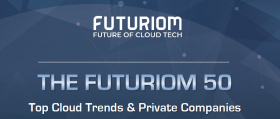2024 Trend Preview: Edge Cloud and Data Management Convergence

(Editor's note: This is a multipart series in which Futuriom profiles the trends we expect to drive cloud technology in 2024, as well as the top private companies that have been featured on our 2023 Futuriom 50 list or those being considered for 2024. The new report will be out at the end of January.)
The field of edge cloud and data management is broad and deep. Enterprises are increasingly looking to the network edge, where proximity to data improves application efficiency and performance. At the same time, demand for centralized access to information from multiple sources is growing exponentially, helped by the popularity of generative AI. Add to all this demand for data pipelines, backup, analytics, and observability, and this particular area becomes complex, with many participants intertwined in ecosystems, making it tough to tell partners from competitors.
Despite the complexities, it’s possible to list some micro trends in this area, associated with the following key terms:
- Distributed databases and edge convergence
- Unified data management
- Data streaming and data pipelines
- Networking for the edge
Distributed Databases and Edge Convergence
Enterprises, responding to the wider reach enabled by cloud computing and the shift to remote work, increasingly require distributed data architectures, which support lower latency, better overall performance, and operational savings.
These architectural elements include databases and platforms supporting edge applications, which are growing in popularity at manufacturing facilities, oil and gas rigs, retail operations, and other locations requiring solutions that generate information as close as is physically possible to where data is generated.
Here are some of the companies we are watching in 2024 that play a part in the edge convergence trend:
Cockroach Labs has become one of the best-known providers of a database capable of working at the network edge. Its cloud-native, distributed SQL database, CockroachDB, runs in hybrid and multicloud environments, including AWS, Azure, GCP, Red Hat, Snowflake, VMware, and others. Cockroach also comes in a serverless version or can be hosted on premises. CockroachDB stores copies of data in multiple locations to optimize performance and is impervious to failures, restoring data as usual regardless of any outage across the network. Customers include Bose, Comcast, eBay, Lush Cosmetics, Norfolk Southern, Orca Security, and Rubrik, to name a few.
Yugabyte is also making waves as a distributed SQL database available on premises, as a managed public (AWS, GCP, Azure) or private cloud service, or as an open-source implementation. YugabyteDB is designed for stateful edge applications that entail streaming data, real-time analytics, and transactional workloads. It can be deployed with Kubernetes for developers and supports a variety of programming languages. Customers include Netskope, Kroger, Jakarta Smart City, and the Catalan Health Authority, to name just a few.
ClearBlade links enterprise applications to Internet of Things (IoT) systems via a SaaS platform that includes inline stream processing, security, connectivity with internal and external data stores, and artificial intelligence (AI). The ClearBlade IoT Core provides "one click" migration to Google Cloud's IoT Core. Once migrated, ClearBlade's Edge Platform offers a range of services for edge applications, including multifaceted security, data filtering and streaming, and integration for multiple protocols, clouds, and gateways.
Zededa aims to orchestrate devices and applications at the network edge, including cameras, sensors, industrial controls, etc., using microservices designed to carry only the operating system needed to run the app (no runtimes or libraries are included that may slow things up). Zededa works via its own API with Kubernetes, Docker, and virtual machines to speed up edge applications and reduce operational costs.
There are a range of emerging companies focused on delivering applications at the edge, also known as edge convergence. Among these is Fly.io, a startup that creates Linux-based virtual machines called Fly Machines that run on dedicated bare metal hardware in over 30 regions globally. The distributed service requires minimal coding, and Fly.io claims it can substantially improve the performance of edge applications. While little information is available about Fly.io customers, its investor list is impressive, including Intel Capital, Dell Technologies Capital, Andreessen Horowitz, Geodesic Capital, and EQT Ventures.
In a different approach to the edge, Betacom offers 5G in a fully managed, end-to-end private wireless service, giving U.S. enterprises access to fast 5G networks that enable edge applications in areas such as manufacturing robotics and transportation and logistics tracking. Betacom delivers 5G network management via its cloud-based Security and Service Operations Center (SSOC) built on a zero trust model. The company has a growing list of partnerships, including with UScellular and Siemens in the U.S.
Unified Data Management
Enterprise IT also requires unified access to data across multiple platforms and clouds. Data from enterprise resource planning (ERP) systems, Salesforce applications, and a variety of databases from IBM, Oracle, SAP, and others must be gathered for observability, management, analytics, billing, and a range of other functions. Growing adoption of generative AI is likely to multiply the need to centralize data from many silos.
In this space we see the ongoing popularity of the data lakehouse, a term coined by startup Databricks that refers to the combination of data warehouse and data lake functions. A data warehouse, of course, is a repository for data from multiple similar sources; a data lake stores data in its original state, whether that is structured or unstructured. From a common, cloud-based data lakehouse, Databricks orchestrates data for business intelligence, data warehousing, AI functionality, applied data science, and more. By unifying data for a variety of functions, Databricks allows enterprises to maintain silos while feeding data from those silos to vital applications.
Over the past several years, Databricks has grown exponentially. Its valuation in September 2023 was reportedly $43 billion. It has expanded its reach globally and has over 5,400 employees. Word is that the company is set to go public soon.
Data is also unified for backup and recovery. In this area, Rubrik offers a zero-trust platform that backs up data across multiple environments. In addition to unifying data in a protected location, Rubrik also analyzes data using machine learning and AI, identifying problems and implementing user-defined policies. Customers include Carhartt, Harvard University, KeyBank, and Pepsico, to name a few.
Chronosphere offers a cloud-native observability and metrics-tracking platform that monitors enterprise data generated by IT resources in order to manage data growth, improve workload efficiency, reduce unnecessary processing costs, and remedy problems. The managed service is based on an enhanced version of the open-source M3 system. It creates metrics for containerized infrastructure, microservices applications, storage, and business services and sets up traces to identify and fix problems in this IT infrastructure. Customers include Robinhood, Snap, Obsidian Security, DoorDash, Zillow, and Visa. Chronosphere is also part of the strong cloud cost management and observability trends, which we'll be profiling in the next two weeks.
Data Streaming and Data Pipelines
In today’s increasingly competitive digital world, enterprises require access to data as quickly as possible. Streaming data from sources to destinations in a real-time, continuous flow results in better performance.
In this camp are companies such as Hazelcast, which provides a low-code, distributed platform that relies on data streaming and in-memory architecture to speed development of cloud-based applications. The software adds contextual information to retrieved data to enable real-time responses to incoming prompts. A bank customer at an ATM, for instance, can be served a loan application while getting cash. Hazelcast software runs on premises, at the edge, or hosted in AWS (with Azure and GCP hosting scheduled for midyear 2024).
Another firm, Striim, offers a data integration and streaming platform that transfers data to and from over 150 sources and targets, including Databricks, Snowflake, and Microsoft Fabric, along with cloud services such as AWS, Azure, and Google Cloud, as well as a variety of other cloud storage services, DBMSs, log files, messaging systems, and sensors. While the data moves in real time, Striim can apply artificial intelligence (AI) to analyze it and make any changes needed for use in the target system. Customers include American Airlines, Ciena, Macy’s, Discovery Health, Kyocera, Orange, RWJ Barnabas Health, and Statistics Canada.
Fivetran offers a SaaS-based, API-driven series of connectors between enterprise data sources and destinations. In enterprises that deploy hundreds, if not thousands, of distinct cloud-based and on-premises data sources, this approach, which calls for little or no coding, can eliminate the extensive development work formerly required to achieve this kind of connectivity. Fivetran claims an impressive and growing list of over 6,000 customers, including La-Z-Boy, Conde Nast, JetBlue, Snowflake, Autodesk, the Denver Broncos, Dropbox, and Pitney Bowes, to name just a few.
Networking for the Edge
In another approach to speeding up edge performance, Graphiant is trying to simplify the routing of apps across hybrid networks via a stateless routing core, which also provides firewall functionality to empower the network edge. The cloud service, called the Graphiant Network Edge, tags remote devices with packet instructions to improve performance and agility at the edge compared to MPLS or even SD-WAN. A Graphiant Portal enables policy setup and connectivity to major public clouds.
In a similar vein, Prosimo offers secure mesh networking between clouds. The platform creates a secure, multi-cloud transit network that links over cloud-specific content delivery networks (CDNs) to multiple edge locations. The network also supports microsegmentation at the application level, making for even more secure edge access.
Aviz supports multi-vendor devices that use the open-source SONiC network operating system to create a network fabric that supports environments ranging from datacenters to edge networks. Its Open Network Enterprise Suite (ONES) supports both Community SONiC and multiple vendor-specific distributions for overall management and orchestration. The platform monitors network traffic, bandwidth utilization, and system health, along with other functions and characteristics throughout all areas of the network fabric, including the edge.
Hedgehog also was founded with a view to improving and extending SONiC to enable compute work at the network edge. The software operates on a range of hardware switches, smartNICs, and DPUs from Celestica, Dell, Edgecore Networks, NVIDIA, and Wistron. It features a guided setup option to establish an enterprise network via this range of devices, which can then be programmed with Terraform, Ansible, or the Kubernetes API.
Netris is an automatic network operations platform that delivers network-as-a-service (NaaS) automatically over existing physical datacenter, bare metal, or edge environments. Netris creates a virtual private cloud that furnishes routing, load balancing, security, other essential network services along with monitoring and analyses and automated remediation of network anomalies.
The companies listed above are a sampling of what Futuriom perceives to be highly innovative firms in the edge cloud and data management sector. Stay tuned for our 2024 Futuriom 50 report, which is coming out in just a few weeks.


















